THE OLYMPIAN

MEXICO CITY 1968 OLYMPIC GAMES OPENING CEREMONY OCTOBER 12, 1968
Winter Issue 2018

A Letter From Richard Fosbury
U.S. Olympians and Paralympians Association President

Dear U.S. Olympians and Paralympians,
“Athletes First” was the message USOPA promoted at the 2018 U.S. Olympic and Paralympic Assembly in Colorado Springs, where we distributed stickers to athletes and the USOC Administration. The tagline was borrowed from Athletes Advisory Council (AAC) Chair Han Xiao after he testified in Washington, DC and we realized this is what our Association is about and the message we want spread across the country during Olympian and Paralympian activities.
Winter season is always a time to reflect on the year and look forward to what will happen in 2019. The buildup to PyeongChang 2018 Olympic and Paralympic Games was exciting and as always, the performance of all the athletes exceeded expectations. While we have all shared the disappointment when our athletes slip, fall, or miss the finals, we are lifted by the joy of effort made. Expected champions returning to the podium and the surprise of new medalists emerging are equally inspiring. Boarding, curling, hockey, skating, skiing, and all the sports performed by Olympians and Paralympians, it was an unforgettable winter.
I was curious to see what would be new at the Youth Olympic Games in Buenos Aires in October, I was not disappointed! We had 87 athletes compete in 21 different sports. I love how the Games were re-structured: this year there were mixed-country and mixed-gender competitions, X-Games style. As a kid, we would always mix up the rules of the game and it was fun to see the Games be so creative.
While 2019 is a non-Games year, athletes continue to train, practice, and plan for the highest level of competition. World Cup or World Championships will be held in different sports and we’ll get to follow our favorite athletes and teams. All of this leads to the Tokyo 2020 Olympic and Paralympic Games. We will see new sports like surfing, skateboarding, sport climbing, karate, and the return of baseball/softball, plus several new mixedgender events. Lots to watch on the Olympic Channel! It will be exciting for some of the 1964 athletes to return to Tokyo. I’m confident the Games will be a great success for the Japanese hosts.
MOTTO: ONCE
ALWAYS
NEVER
®
AN OLYMPIAN;
AN OLYMPIAN
FORMER; NEVER PAST
During the 2018 Games, we witnessed the sentencing of a national team doctor for abusing female athletes for decades, following the brave testimony of many of the survivors. This shook us to our core; it raised the question how this could go on for so long and created much anger at the coverup. I’ve read the Executive Summary of the Ropes and Gray report and encourage everyone to do the same. We have new leadership at the USOC; USOPA and AAC have voiced our commitment to help change the culture. It was a serious mistake to prioritize the winning of medals above the health and safety of athletes. We are better than this. We will stand to support the recovery of the abused athletes and demand for a system that truly holds Athletes First.
I was blessed to participate in several reunions with my Mexico City 1968 teammates, it was wonderful to renew friendships and share in storytelling.
Attitude is everything! I hope you all get plenty of exercise this winter, don’t let the weather deter you! Invite someone you care about to join you, sharing always makes it more fun.
I wish to send everyone best wishes for 2019 and ask that you be generous and always share your smile.

Yours in Olympic spirit, Richard Fosbury
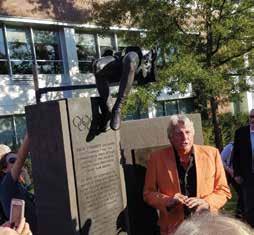
2018
Cover image: During the imposing parade of the 111 teams, the large and impressive double block from the United States was greeted with admiration and respect by the 80,000 spectators. Self-assured happiness beams from the faces of the young men and women from the USA – they know that they represent the largest sporting nation in the world, as do their deserving leaders.
Janice Lee York Romary, who led the United States delegation into the stadium in Mexico City, was the first American woman to compete in six Olympic Games, appearing consecutively from 1948 thru 1968. In this, her final Olympics, she was selected to carry the U.S. flag at an Opening Ceremony, this was the first time a woman was given that honor. During her career, Romary won 10 U.S. championships in foil, still a record for men or women, and won a gold medal in the women’s foil at the 1967 Pan-American Games. She later became the fencing commissioner for the 1984 Los Angeles Olympics.
Inside 2 A Letter from Dick Fosbury 4 Mexico City 1968 Olympic Games 9 Book Review & SafeSport 10 Athlete Career and Education (ACE) 13 USOPA REUNION 2019 14 USOC Archives & Archivist News 16 Member of the 1968 Olympic Team 18 Updates from the LA84 Foundation 21 Alumni In Honor, Alumni In the News, Milestones 22 In Memoriam 29 USOPA Executive Committee 30 Olympian & Paralympian Photo Highlights 32 U.S. Olympians & Paralympians Chapters
Photo Credit: Crawford Family U.S. Olympic Archives/USOC
THE OLYMPIAN NEWSLETTER 3
Dick Fosbury Statue Unveiling Honoring U.S. Olympic Hall of Famer and innovator of the Fosbury Flop Oregon State University October 19,
12 WAYS THE MEXICO CITY 1968 OLYMPIC GAMES INFLUENCED THE COURSE OF HISTORY
By: Karen Rosen
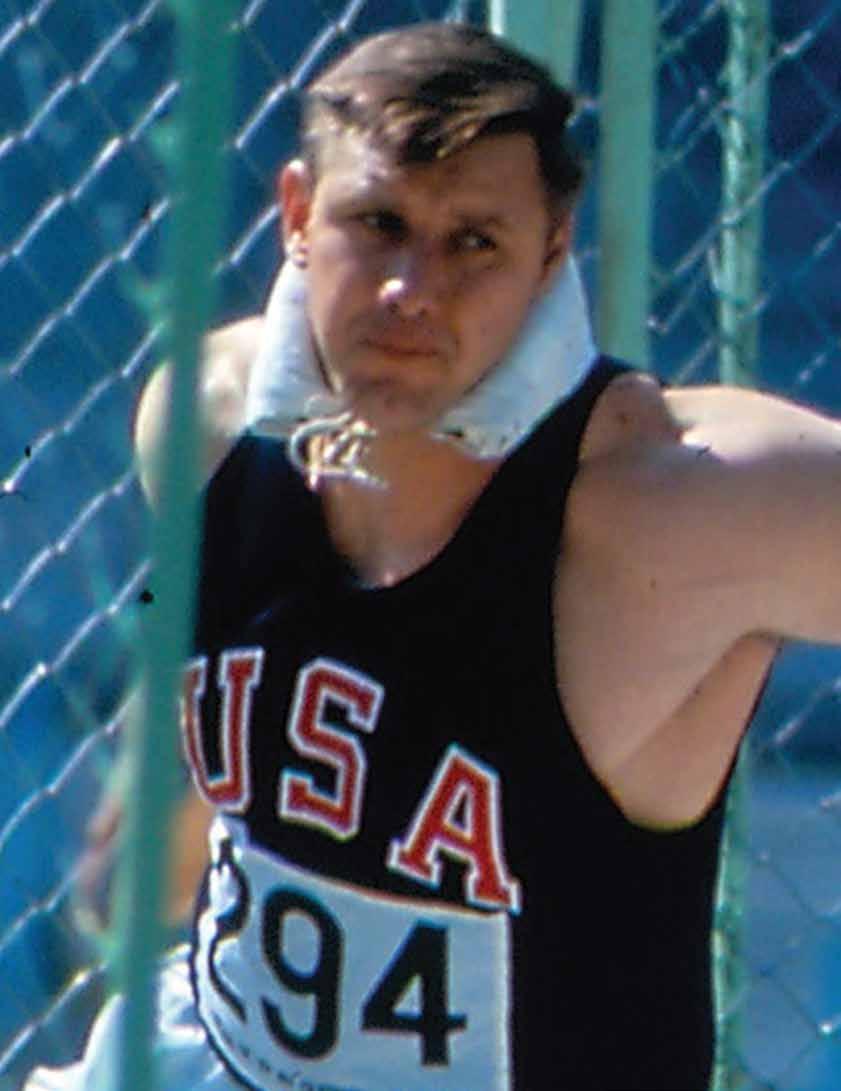
Fifty years after the Mexico City 1968 Olympic Games, the performances, records, innovations and, yes, that famous protest still echo today.
As the last Games of the turbulent 1960s, the Mexico City Olympics were the first to be held in Latin America and also the first in a Spanish-speaking country.
Team USA led the medal table with a total of 107 medals – 45 gold, 28 silver and 34 bronze – its highest output since 1904 on home soil in St. Louis.
More than half of those medals came in the pool where Team USA won a whopping 52 medals in swimming and six in diving.
The track and field team added 28 medals, many of the 15 gold coming in spectacular fashion.
Here are 12 ways the 1968 Games made their mark on history and continue to resonate today.
1. BLACK POWER SALUTE
Tommie Smith and John Carlos raised gloved fists in the “Black Power Salute” on the podium.
After Smith won the gold medal in the 200-meter with Carlos capturing the bronze, they made a stand to protest racial inequality in the United States. The sprinters were part of the “Olympic Project for Human Rights” organized by Harry Edwards, their sociology instructor at San Jose State. Edwards originally advocated boycotting the Games.
Lew Alcindor, now Kareem AbdulJabbar, refused an invitation to try out for the U.S. basketball team to protest the treatment of black athletes. However, African-American track and field athletes opted to attend the Games and protest in their own way. For example, double gold medalist Wyomia Tyus wore black shorts. The men’s 4x400-meter team wore black berets on the podium and raised a clenched fist as they walked out of the stadium.
4 THE OLYMPIAN NEWSLETTER
But Smith and Carlos grabbed the headlines. Their medal ceremony became one of the iconic images of the Games and is compared today to Colin Kaepernick, the quarterback who began kneeling during the national anthem at NFL games to call attention to racial inequality and police brutality.
After Smith ran a world record of 19.83 seconds, breaking Carlos’ mark of 19.92, the Americans wore black socks on the podium with no shoes to symbolize black poverty. Smith tied a black scarf
Teammate Lee Evans wanted to withdraw from the 400-meter final to show solidarity with Smith and Carlos, but Carlos persuaded him to run. Evans led a U.S. sweep, winning in a worldrecord time of 43.86 seconds, which lasted for 19 years.
Cuba, which took second in both the men’s and women’s 4x100s, announced it was sending all of its silver medals to Black Panther leader Stokely Carmichael as “a symbol of protest of the treatment of the black man in North America.”


around his neck to represent black pride. Because they only had one pair of gloves, they each took one glove. They also wore Olympic Project for Human Rights buttons, as did silver medalist Peter Norman of Australia. During the national anthem, Smith and Carlos raised their fists and lowered their heads in a silent, non-violent protest. “The totality of our effort was the regaining of black dignity,” Smith said.
Under pressure by the International Olympic Committee, which threatened to disqualify the entire U.S. track team, the United States Olympic Committee suspended Smith and Carlos and forced them to leave the Olympic Village. They were also ordered to leave Mexico.
2. A HIGH-ALTITUDE GAMES
The Games were the first to be held at high altitude.
At an elevation of nearly 7,400 feet, the thin air in Mexico City provides only 77 percent of the oxygen at sea level. This led to a slew of records in track and field –including two lasting more than 20 years – but near tragedy in the pool. Michael Wenden of Australia lost consciousness after winning the 200-meter freestyle and nearly drowned and silver medalist Don Schollander of the United States had to be given oxygen.
While the altitude slowed down distance runners, sprinters and jumpers had a field day. They smashed world records
in the men’s and women’s 100- and 200-meters, the men’s 400, the men’s and women’s 4x100s, the men’s 4x400, the men’s 400 hurdles, the men’s and women’s long jumps and the men’s triple jump. The world record was also tied in the men’s 800 and set in the women’s shot put, while Olympic records were established in nearly every other event. Three of those world records were chased for many years by athletes who seldom had the opportunity to compete at altitude. No Games have been held at such a high elevation since 1968.
The men’s 4x400-meter team ran 2:56.16, a record lasting 24 years. It was finally eclipsed at the Barcelona Games in 1992 by Team USA.
Tyus became the first athlete, male or female, to repeat as 100-meter Olympic champion. She also was the first woman to run a legal time of 11.0 seconds (handtimed). Four of the five world record holders at 11.1 were in the Olympic final.
Jim Hines of Team USA was the first man to run under 10 seconds officially in the 100 with a time of 9.95 seconds in the first all-black final in the event.
Although the altitude was more of a curse than a blessing in the longer events, Madeline Manning prevailed in the 800-meter. She was the only U.S. woman besides Tyus, a fellow Tennessee State Tigerbelle, to win an individual gold medal. Manning, who has been a Team USA chaplain at the Olympics, remains the only American woman to win the 800 at the Games.
3. BEAMON SETS A STILLSTANDING OLYMPIC RECORD
Bob Beamon soars 29 feet, 2 ½ inches in the long jump.
In the rarefied air of Mexico City, Beamon uncorked a legendary leap. But first, he drew comparisons to 1936 champion Jesse Owens – but not for the right reasons. Like Owens, Beamon had two fouls in the preliminaries and only one more chance to post a legal jump. Team USA’s Ralph Boston advised him to jump well before the takeoff board, just like
THE OLYMPIAN NEWSLETTER 5
Tommie Smith raises his fist for Human Rights at the Mexico City 1968 Olympic Games.
Germany’s Luz Long advised Owens.
On Beamon’s first jump in the final, he flew incredibly high over the sand. The judges had to use a steel tape because their optical measuring device was not long enough. Beamon wasn’t that familiar with the metric system, so he wasn’t as impressed with 8.90 meters as he should have been. When he saw the converted measurement, he collapsed. Beamon had sliced a full 21 ¾ inches off the previous world record of 27-4 ¾.
Reigning Olympic champion Lynn Davies of Great Britain told Boston, “I can’t go on. What is the point? We’ll all look silly.” Then Davies told Beamon, “You have destroyed this event.”
Beamon never jumped over 27 feet again. In 1991, Mike Powell of Team USA went 29-4 ¼ to set a new world record, but Beamon still holds the Olympic record after 50 years.
Boston, the 1960 gold medalist and 1964 silver medalist, went on to win the bronze to complete his Olympic collection.
4. TEAM USA’S UNPRECEDENTED DOMINATION IN SWIMMING
Of the 553 medals won by the United States in swimming the last 122 years,
nearly 10 percent are from Mexico City. Team USA won 52 of the 87 available medals, winning 11 of 14 women’s events and 10 of 15 men’s events. The United States won 21 gold, 15 silver and 16 bronze medals and made the podium in every event. Among the 50 other countries, Australia and the Soviet Union were tied for second with eight medals apiece.
This was a complete team effort, with no swimmer winning more than three gold medals.
Debbie Meyer, a 16-year-old Californian, was the standout by becoming the first swimmer to win gold medals in three individual events: the 200, 400 and 800-meter freestyles. The 200 and 800 were both new Olympic events for women. No other athlete equaled Meyer’s feat in the freestyles until Katie Ledecky in 2016 (Janet Evans won the 400 free, 800 free and 400 IM in 1988).
Charlie Hickcox won three gold medals (200 IM, 400 IM, medley relay) and one silver (100 backstroke). Claudia Kolb won the women’s 200 IM and 400 IM. Her Olympic-record time of 5:08.5 in the 400 IM gave her the most decisive women’s swimming victory in 40 years, as teammate Lynn Vidali was second in 5:22.2.
Team USA went on to win 43 medals
Top roll: Jim Henry competes in the men’s springboard at the Mexico City 1968 Olympic Games and Dick Fosbury sets an Olympic record in the men’s high jump at the Mexico City 1968 Olympic Games. Second roll: L-R) Jan Henne, Debbie Meyer and Jane Barkman sweep the podium in the women’s 200-meter freestyle at the Mexico City 1968 Olympic Games
Bottom roll: Bob Beamon breaks the world record in the long jump at the Mexico City 1968 Olympic Games and (L-R) Mark Spitz, Doug Russell and Ross Wales sweep the podium in the men’s 100-meter butterfly at the Mexico City 1968 Olympic Games and Lee Evans competes in the men’s 400-meter at the Mexico City 1968 Olympic Games.

in Munich four years later, then 34 in 1976. With such lopsided medal tables, the IOC decided to cut the number of individual entrants per country to two instead of three for the 1980 Games, a restriction which continues today.
5. Mark Spitz Debuts
Mark Spitz made his first Olympic appearance.
Before “Spitzian” became synonymous with incredible success, the brash swimmer suffered a blow to his confidence.

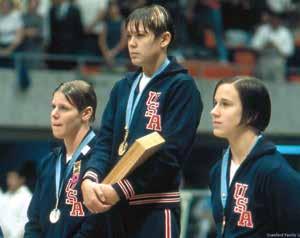



6 THE OLYMPIAN NEWSLETTER
Spitz predicted he would win six gold medals in Mexico City, but came up short with only two relay gold and a silver in the 100-meter butterfly. He was eighth in the 200 butterfly despite holding the world record. Four years later, Spitz was the first athlete to win seven gold medals at one Games, a record that stood for 36 years until Michael Phelps eclipsed him with eight in Beijing.
6. THE FOSBURY FLOP
Dick Fosbury introduced a new technique to the Games.
As one of the worst high school high

jumpers in the state of Oregon, Fosbury was desperate to get over the bar. During a meet, he improvised a new technique, which he originally called the “back layout.” He later changed the name to the Fosbury Flop.
Although he was ridiculed for going over the bar backward, Fosbury defied his coaches’ wishes to try a more conventional style.
In 1968, he improved 5 ½ inches in less than nine months, culminating in Mexico City when Fosbury jumped 7-4 ¼, a new personal and Olympic record. The crowd was enthralled, and the worldwide attention led to a revolution in the sport.
Four years later in Munich, 28 of the 40 competitors were using the Fosbury Flop, with one exception being the Olympic champion. All Olympic champions, male or female, starting in 1980 have used the Flop.
“He was like the Beatles, breaking new ground,” the late Track & Field
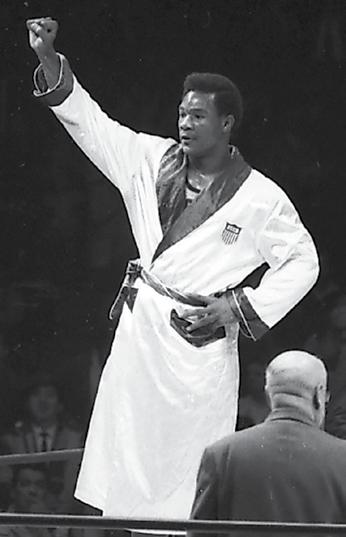

News writer Jon Hendershott said in the new book, “The Wizard of Foz –Dick Fosbury’s One-Man, High-Jump Revolution.”
7. GENDER TESTING MAKES ITS DEBUT
Athletes underwent gender testing for the first time at the summer Games.
In an effort to keep men from competing in women’s events, the IOC began testing athletes in 1968. A chromosome test was conducted after swabbing the inside of the athlete’s cheek.
Mandatory gender testing ended in 1999, although individual athletes could still be evaluated.
The drastic improvement of Caster Semenya of South Africa in 2009, when she won the world championship at 800 meters, led to controversial gender verification testing. Since then, the IOC and international track and field federation have struggled to come up with guidelines involving testosterone levels that are fair for all athletes.
8. DOPING DISQUALIFICATION BEGINS
The first Olympic athlete was disqualified
under new doping regulations.
Hans-Gunnar Liljenwall, a Swedish modern pentathlete, claimed he drank beer to calm his nerves before the shooting competition. When he tested positive for alcohol, he cost his country a bronze medal. Doping is an ongoing problem in sports, with athletes testing positive at every Olympic Games, although usually for performanceenhancing drugs instead of beer.
Liljenwall went on to compete in the 1972 Games, presumably without quaffing any alcohol, and Sweden placed fifth.
The international federation instituted doping controls after the 1965 world championships in which Austrian athlete Hubert Polzhuber apparently drank 10 beers and a bottle of cognac before shooting all of his bullets into the ground.
9. GEORGE FOREMAN MAKES A NAME FOR HIMSELF
George Foreman won the super heavyweight boxing gold medal.
Despite having fought in only 18 bouts before the Games, Foreman defeated Jonas Cepulis of the Soviet Union with a second-round TKO for the gold. He then waved a small American flag in the ring.
Foreman became the third straight U.S. boxer to win the world heavyweight title after claiming Olympic gold. Cassius Clay, who fought in the light heavyweight division in 1960, was the first, followed by super heavyweight Joe Frazier in 1964.
In 1973, Foreman knocked out Frazier to earn the world heavyweight title, retiring four years later. He launched a comeback in 1987 at age 38. On Nov. 5, 1994, the 45-year-old Foreman knocked out Michael Moorer to become the oldest fighter to win the WBA heavyweight crown.
10. AL OERTER EARNS HIS FOUR-PEAT
Al Oerter is the first track and field
5. THE OLYMPIAN NEWSLETTER 5 THE OLYMPIAN NEWSLETTER 7
George Foreman wins gold in heavyweight boxing at the Mexico City 1968 Olympic Games.
athlete to win the same event four times.
Oerter won his first Olympic gold medal in the discus at age 20 when he wasn’t the favorite by any stretch of the imagination at the 1956 Melbourne Games.
Severely injured in a car accident a year later, Oerter was back for the Rome Games, where he defended his title. Hampered by neck and rib injuries four years later, Oerter fought through the pain to win again.
Finally, at age 32, he was the underdog in Mexico City. Teammate Jay Silvester, the world-record holder, led the qualifying with an Olympic-record toss.
Rain delayed the final an hour, which threw Silvester off. But Oerter was on fire. In the third round, he heaved the discus 212-6, five feet farther than his previous best. He also threw 212-5 and 210-1 to prove that was not a fluke.
Oerter was the first to win his track and field event four times, a feat equaled by Carl Lewis in 1996.
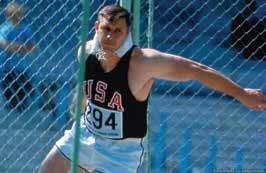
Oerter came out of retirement in 1980 and was fourth at the Olympic Trials, which were held despite the U.S. boycott of the Moscow Games.
11. WILLIE DAVENPORT ON TRACK TO BECOME TWOSPORT OLYMPIAN
Little did Willie Davenport know in 1968 that he would go from hurdling down a track to hurtling down a mountain in a bobsled. A 1964 Olympian, he was so nervous before the 110-meter

hurdles in Mexico City that he almost fell down while taking off his sweat pants. Davenport went on to run 13.33 seconds, equaling the Olympic record.
He placed fourth in Munich, then won the bronze in Montreal.
While it is common now for athletes from summer sports to take up bobsled, that wasn’t the case when Davenport answered the call to switch sports. He made Team USA after only three months of training. At age 36, Davenport competed in his fifth Olympics, this time at the Winter Games in Lake Placid in 1980, placing 12th. Davenport, teammate Jeff Godley and Bob Wilson of Canada were the first black athletes to compete in the Winter Games. Davenport also was the first track athlete and only the fourth in any sport from Team USA to compete in both summer and winter Games.
12. GROUNDBREAKING COLOR BROADCAST
The 1968 Games are the first in which a majority of the events – not just the opening and closing ceremonies – are broadcast worldwide in color.
In the United States, ABC produced its first summer edition of the Games (having already televised Winter Games from Innsbruck in 1964 and Grenoble in 1968).
Thanks to satellites and a convenient time zone, a lot of the competition during the 43.5 hours of coverage was shown live.
ABC paid $4.5 million for the rights, a far cry from the $50,000 CBS paid to show


the Olympic Winter Games Squaw Valley 1960 – the first to be shown on television in the United States.
In the most recent deal, NBCUniversal, the current Olympic broadcaster, acquired broadcast rights across all media platforms, including free-toair television, subscription television, internet and mobile, for 2021 through 2032 for $7.65 billion, plus a $100 million signing bonus to be used for the promotion of Olympism and the Olympic values between 2015 and 2020.
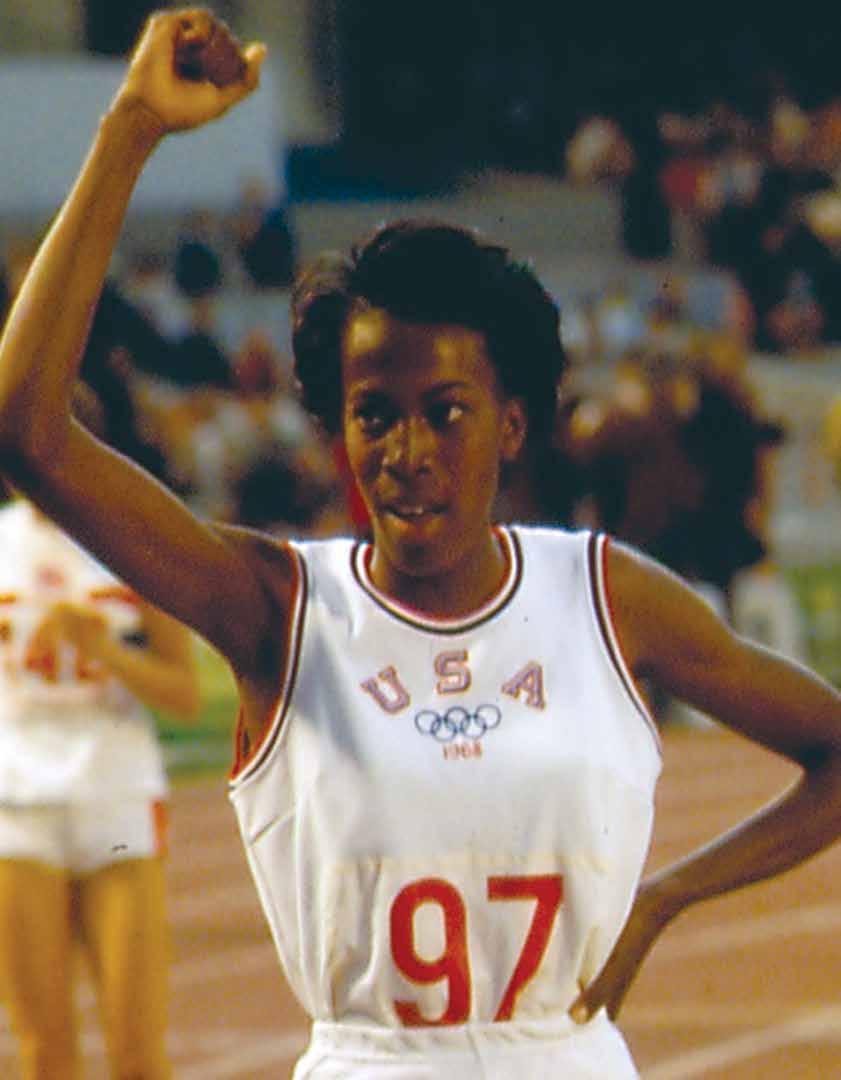
5. 8 THE OLYMPIAN NEWSLETTER
Al Oerter competes in the discus at the Mexico City 1968 Olympic Games.
Top to bottom: Wyomia Tyus competes in the women’s 100-meter at the Mexico City 1968 Olympic Games and Madeline Manning Mims wins gold in the women’s 800-meter at the Mexico City 1968 Olympic Games.
Willie Davenport competes in the men’s 110-meter hurdles at the Mexico City 1968 Olympic Games.
BOOK REVIEWS
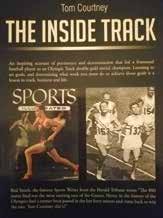
The Inside Track
Tom Courtney’s The Inside Track treats readers to a candid and thoughtful memoir on what it takes to succeed, not just as a world class athlete, but in life. In 153 thoughtful, fast-paced pages, Courtney tells us of a supportive family, grueling
workouts, rivalrous personalities on the track and in business, and his strong religious faith.
His clear, clean (no curse words) anecdotal prose makes a great read for both teenage and adult book shelves and well worth the time for athletes of all ages.
Courtney tells readers of the wise coaching of his father who pitched for the Yankees in 1928 but left baseball to support a young family; of Artie O’Connor, his Fordham coach who mentored Courtney’s rise to world class competition; and what motivated him against his rivals on the track. We also learn of Wes Santee, touted as the first man likely to run the four-minute mile but who never did; of Mal Whitfield,
holder of multiple Olympic titles and world records; and Arnie Sowell, an archrival who led but faded in a race when Courtney took, lost, and regained the lead in the final splitsecond of his gold-winning 800meter Olympic run in Melbourne, Australia in 1958.
Runners of all ages have much to learn from The Inside Track and –of incredibly hard and repetitive workouts on the practice track that made Courtney not only stronger but much faster.
But make no mistake, Courtney writes on more than running. Anyone serious about life needs to read every word of the Inside Track’s chapter on Values and Religion.
•
• Received over 1,500 cases
• Resolved 250 cases resulting in sanctions of suspension or permanent ineligibility Education,
•
•
THE OLYMPIAN NEWSLETTER 9 To report a concern: 720-531-0340 www.safesport.org/report-a-concern Main Office Number: 720-531-0344
Helpline (24/7 live, confidential service provided by RAINN): 866-200-0796
Opened
SafeSport
www.safesporthelpline.org
in March 2017 Response and Resolution
Confidential, impartial, and independent.
Prevention and Outreach
SafeSport trainings completed since opening 03/2017 - 570,000
New!
How to contact the Center:
Free Parent and Youth Resources https://safesport.org/resources.org
ACE MENTOR NEWS
INVENERGY POWERING DREAMS ON, OFF THE PODIUM
As a boy growing up in the Soviet Ukraine, Michael Polsky remembers watching the Olympics on television. He dreamed of attending one day but during Soviet rule, people did not have the luxury of unrestricted movement. Experiencing the Games became a dream, the ultimate expression of freedom.
That vision, along with a robust competitive spirit, energized him and has driven a lifelong commitment to investing in elite athletes, on and off the field of play.
Polsky founded Chicago-based Invenergy, a billion-dollar clean energy company, in 2001. The firm has wind, solar and natural gas facilities and is reportedly one of the nation’s six largest owners of wind generation plants.
As a former United States Olympic and Paralympic Foundation board member, Polsky is interested not only in supporting athletes through sport but inspiring entrepreneurship and innovation that transcends their athletic abilities and fuels long term career goals.
At its core, entrepreneurs and highperformance athletes share common

characteristics in pursuing their dreams, pushing through adversity and taking risks to win. He believes entrepreneurship drives today’s market economy so investing in Team USA is smart, not only in preparing athletes for international competition but as future business leaders.
“Being an entrepreneur takes grit, determination, creativity and perseverance,” states Polsky. “You have to be able to take failure head on, push
through difficult times and embody the mental toughness to withstand the pressure. These are the same qualities that many Olympic and Paralympic athletes have already mastered and demonstrated on the world stage.”
Two years ago, the company launched the Invenergy Fellowship Program which provides Olympians and Paralympians short term internships at one of Invenergy’s multiple locations throughout the United States and
10 THE OLYMPIAN NEWSLETTER
Founder of Invenergy and former U.S. Olympic and Paralympic Foundation Board Member, Michael Polsky, launched the Invenergy Fellowship Program.
learning about renewable energy. To date, four Team USA athletes have participated in the program, with the two who completed it ultimately accepting full time positions.
Polsky adds, “I have tremendous respect for anyone who discovers their passion and drives themselves to achieve success at the elite level. I discovered my passion for building power plants and studying efficient ways to consumer energy. To build something so massive and have it go from paper to reality was invigorating. For athletes, the Fellowship Program allows them to see how they can translate their skills into a new career, sparking a new passion and building their next opportunity.”
Reid Pletcher, international world cup skier and Paralympian Guide, was a cross-country ski guide to athlete Jake Adicoff in the Sochi 2014 Games. He competed professionally on the Sun Valley Ski Education Foundation Gold Team, the US Speed Skating Club and earning multiple international podium finishes.
Complimenting his accomplishments in sport was Reid’s educational background from the University of Colorado at Boulder in finance, real estate, and engineering. He has learned that leveraging his experience in sport has served him well in the workplace.
“My year as a Paralympic visually impaired ski guide were the best months of my life. I loved the ability to compete fulltime in my own discipline but as part of a team,” states Pletcher. “There was definitely a rewarding realization that the better we skied as “one athlete” rather than two, the higher the chances we could outperform everyone’s expectations. I believe individual success is great but succeeding as a

team has more emotion and depth and power than any one person could create alone. That dynamic holds true in the office too.”
The United State Olympic Committee’s (USOC) Athlete Career Education (ACE) program introduced Reid to the Invenergy Fellowship Program. He started working in the development department at Invenergy’s Denver office and was recently offered a full-time position at the end of the program as the Renewable Energy Development Coordinator.
Pletcher adds, “Participating in the Invenergy Fellowship Program was an easy decision because I have spent most of my life on small ranches in Idaho that were built around 100% renewable energy and off-the-grid living. I have always had a personal connection to wind and solar development. Invenergy allowed me to enter a career that I truly believed in and apply my undaunting work ethnic and determination to

THE OLYMPIAN NEWSLETTER 11
Reid Onsite/Reid at Invenergy: Reid Pletcher explores Invenergy’s wind farm in Peetz, Colorado.
succeed, a common characteristic in elite athletes. It also gave me the confidence and conviction that I had tangible value beyond sport.”
Today, Reid is scouting potential solar projects in southwest Colorado, challenged with converting vacant land into 100% fully operational solar farms that will generate 50 to 200 megawatts of renewable energy.
Aja Evans, a two-time Olympian and bronze medalist in bobsled at the Sochi 2014 Games, started a fellowship this past November on the Invenergy communications team. Intrigued by the opportunity, Aja was interested in gaining experience at a growing company.
“For years, I’ve been building my own brand. From a personal website to social media, I have been telling my own story. Now I have the chance to apply those skills in a workplace environment. I realize I have so much to learn and want to absorb as much knowledge as possible.”
Aja, an ACE frequent flyer, has utilized ACE career coaching, applied to the Tuck
School of Business at Dartmouth’s Next Step to Business Program, received ACE tuition funding for certifications. She is also participating in Pivot, a yearlong ACE program that kicks off with 1.5-day workshop that assists retiring athletes in their well-being as whole people, beyond athletics, by providing tools, techniques and a support system to cultivate their next passions and goals as they transition out of elite competition.
“Shifting from sport to the workforce can be a real challenge for elite athletes. ACE’s career, education and life skills programs and services provide athletes the tools needed to take the next step in their careers,” states Leslie Klein, Director, ACE. “Partnering with a global business leader like Invenergy, whose CEO, Michael Polsky sees the potential in channeling athletes’ high performing work ethic into success in business, is a win for all.”
Pletcher adds, “The ACE program acted as a supportive parent or life coach. They have been there for me in this huge life transition and gave me the tools and confidence to move from one life pursuit in sport to the next, a
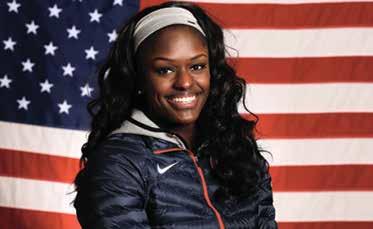
Aja Evans, bobsled medalist, began her communications internship with Invenergy in November.
Aja Evans (left), a bobsled medalist, enjoys a holiday party with her Invenergy Communications team.
career. ACE connected me with other athletes experiencing exactly what I was experiencing and opening the door to opportunities like Invenergy that have made a permanent impact on the trajectory of my life. It has made all the difference.”
Polsky’s generosity is far reaching and clearly focused on inspiring entrepreneurship in the U.S. In addition to supporting Team USA through the Invenergy Fellowship Program, he has given more than $50 million to the University of Chicago for the Polsky Center for Entrepreneurship and Innovation.
“Our hope is more U.S. companies will create customized programs for Team USA athletes, launching their professional careers post-sport. While donor’s financial contributions to ACE programs are invaluable, gifts don’t necessarily have to come in the form of a check. Innovative internships and management training programs for Team USA athletes provide unique experiences that lift athletes and open the door to their future.” adds Klein.

12 THE OLYMPIAN NEWSLETTER

USOPA REUNION 2019
Celebrating our Olympic and Paralympic Spirit
“The greatest Olympic and Paralympic party since the last one”
We are excited to announce that the Early Bird registration for the USOPA Reunion 2019 is now open!
WHEN: November 1-3, 2019
WHERE:
WHY:
REGISTRATION FEE:
The Broadmoor – Colorado Springs, Colorado
To renew friendships and celebrate the unique experiences of the Olympic and Paralympic Games. To support Team USA on their Road to Tokyo 2020 and to have fun!
The Early Bird fee is $250 per adult registration ( this fee will increase to $300 per adult registration on April 1, 2019 ), children (ages 6-12) $75, children 5 and under are complimentary.
The registration deadline is Friday, September 13, 2019.
• The registration fee will cover the following:
• Friday, November 1 – Evening Welcome Reception (Broadmoor Hall)
• Saturday, November 2 – Breakfast of Champions (Broadmoor Hall)
• Saturday, November 2 – Lunch – Games Recognition (Broadmoor Hall)
• Saturday, November 2 – Gala Reception, Dinner Celebration (International Center)
• Sunday, November 3 – Farewell Brunch (Broadmoor Hall)
• Commemorative gift and Reunion photo
• Transportation to/from the Colorado Springs Airport
The USOPA Reunion 2019 negotiated nightly room rate is $169 + tax equals an approximate nightly rate of $190.97. There is a separate daily Resort Service Charge – please see details below. This special rate is available from October 30-November 5 (based on availability). Check in is after 4:00 pm, Check out is before 12:00 pm. The deadline to reserve your room is Friday, September 13, 2019.
RESORT SERVICE CHARGE:
In an effort to add value and simplify incidental fees encompassing a number of guestroom services, offerings and activity access, a resort charge of $32.00 per room plus tax will be added to your account daily. The Service Resort Charge includes:
• Wired and wireless high-speed internet access up to 4MB
• Local and toll-free calls up to one hour
• Online access to over 2,000 newspapers and magazines
• Unlimited access to the Fitness Center
• Two daily group fitness classes: Early Bird Aquatics and Broadmoor Bootcamp
• Resort and activity shuttle service to Cheyenne Mountain Zoo, Starsmore Visitor and Nature Center, The Broadmoor World Arena and The Broadmoor Seven Falls
• Admission to movies and select matiness in The Little Theatre
• In-room hot beverage program: teas, coffee, hot chocolate
• Two bottles of water and ice delivered daily at turndown
• Art and History Tour: Tuesday, Thursday and Saturday at 10:30 am
• Golf Clinic: Tuesday, Thursday and Saturday at 3:00pm (Seasonal)
• All incoming faxes
• Tennis Round Robins: Fridays at 5:00 pm in the Tennis Bubble
• One-hour use of paddle boats (Seasonal)
As we build the daily events for what will be a weekend you do not want to miss, we will be sending out communications on a regular basis via email and in The Olympian. Please make sure you keep us abreast of your current contact information, so you don’t miss any of this very important information.
To register for this exciting event please log onto: http://www.cvent.com/d/nbq51v
Please send all questions to: Reunion2019@usoc.org
THE OLYMPIAN NEWSLETTER 13
REGISTER EARLY TO RECEIVE YOUR DISCOUNTED RATE!!
USOC ARCHIVES & ARCHIVIST NEWS
TERESA HEDGPETH, USOC ARCHIVIST & HISTORICAL STEWARD
As 2018 comes to an end, it is only fitting that we look back and thank all of you who have donated your Olympic and Paralympic artifacts to the archives. This is one of my favorite articles to write each year as it affords me the opportunity to not only list all of the Olympians and Paralympians who have entrusted their history to us; but to also, publicly thank you once again for your dedication and generosity to the archives. Your donations allow us to preserve your history and then share it with others across the country.
This year, the Class of 1968 is heavily represented due in part to their reunion held in Colorado Springs; but more so, because of Tom Lough’s tireless efforts to ensure the Class of 1968 has its history preserved. Of the 22 Olympians and Paralympians who donated this year, almost half were 1968 Alumni.

Opening night of the reunion, I curated a display of 1968 Olympic memorabilia visible as the alumni moved to registration. This vantage point led to several donations on the spot since Tom had previously asked his class to bring artifacts to donate. One such donation was due to Kathy Thomas Young’s 1968 Mexico City Parade Dress on display donated earlier in the year. Unfortunately, Kathy no longer had the parade shoes that went with the dress. When Terry Auda-Frederick heard we did not have the parade shoes, she quickly went upstairs and brought down her Mexico City parade shoes as well as her travel shoes to donate. Other athletes who brought uniform items to the reunion included boxer Al Jones, diver Jim Henry and volleyball player Jane Ward. Thank you, Tom, for facilitating these donations.

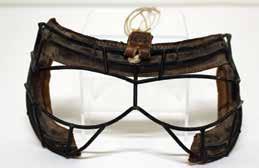
Our oldest Olympian represented this year was Franklin Farrel whose donation was highlighted earlier this year. A 1932 Lake Placid hockey goal tender, Franklin was one of the few hockey players to wear a mask in the 1930’s; his family donated not only his hockey mask but also scrapbooks, medals, and other memorabilia related to Farrel’s Olympic history, including photographs of the 1932 team attending the 1980 Lake Placid Olympic Winter Games as part of their reunion.
Other than uniforms and equipment –which we are very interested in as these items capture not only the history of the Games and our athletes, but also prove how equipment has changed through the years – we have had athletes donated other artifacts related to the Games. Madeline Manning Mims, another 1968 alumni, donated a copy of
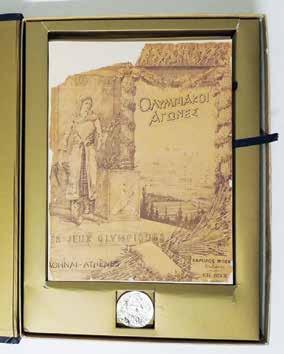
14 THE OLYMPIAN NEWSLETTER
Kathy Thomas Young’s 1968 Mexico City Olympic Games Parade Dress. • Terry Auda-Frederick’s 1968 Mexico City Olympic Games Parade Shoes. • Franklin Farrel’s 1932 Lake Placid Olympic Winter Games Hockey Mask
•
Complete First International Olympic Games Memorabilia
her Applied Research Project – A Survey of Attitude Toward Official Placement of U.S. Christian Sport Chaplains on the U.S. Olympic Teams this year to add to the information available to researchers interested in the Olympic movement. And Phil Reilly, a 1980 & 1984 fencer, donated a complete First International Olympic Games Memorabilia Collection that included a replica of the first medal as well as programs for the 1896 Athens Olympic Games.
Ryan Boyle, a 2016 Paralympic cyclist and silver medalist who just became a two-time world champion, swung by the archives this fall to show us his championship jersey, medals and a Wheaties box created for him by General Mills. After our staff admired Ryan’s collection, he shyly informed us that we could have the Wheaties box if we were interested. Were we?! We gladly accepted it and had Ryan sign it as well. His box is now on display at the Colorado Springs Olympic Training Center as part of the We Train Here Lockers in the visitor center.

In addition to our athletes who have donated, we also received the largest donation of Olympic torches and medals from the president of the U.S. Olympic and Paralympic Foundation, Gordy Crawford. Gordy is passionate about the Olympic movement, our athletes and is an avid Olympic collector. His collection of medals and torches is currenlty housed in our special collections until the U.S. Olympic Museum opens when these items, along with numerous other artifacts from our archives, will be loaned to it for the entire world to be inspired.
We wish to thank all of our Olympic and Paralympic athletes, Team USA members and members of the public who have added to the rich history contained in our archives through their donations; thank you. I look forward to 2019 and to the amazing stories and collections that will be added to the archives next year through your continued support.

Complete list of athlete donations (or their families) by class for 2018:
Franklin Farrel (Family), 1932
George Hague (Family), 1936
Suzy Jones Roy, 1968
Kathy Thomas Young, 1968
Jim Henry, 1968
1968 Alumni Olympian Class
Terry Auda-Frederick, 1968
Madeline Manning Mims, 1968
Albie Axelrod (Family), 1968
Al Jones, 1968
Patty Carreto Brown, 1968
Jane Ward, 1968
Carol Brown, 1976, 1980, 1984
Greg Louganis, 1976, 1980, 1984, 1988
Phil Reilly, 1980 & 1984
Michelle Dusserre-Farrell, 1984
Chris Coleman, 1992 & 1994
Tony Azevedo, 2000, 2004, 2008, 2012 & 2016
Carissa Gump, 2008
Steve Serio, 2008, 2012 & 2016
Raymond Martin, 2012 & 2016
Jared Arambula, 2016
Ryan Boyle, 2016
THE OLYMPIAN NEWSLETTER 15
Ryan Boyle signing his Wheaties box in the archives. Photograph by Teri Hedgpeth. • Ryan Boyle on the front of a Wheaties box in his World Championship Jersey.


1968 OLYMPIC TEAM 50TH ANNIVERSARY REUNION
OCTOBER 26-28, 2018
Members of the 1968 Olympic Team gather for a torch lighting ceremony at the Olympic Training Center, Colorado Spings, Colo. October 27, 2018.
UPDATES FROM THE LA84 FOUNDATION

1. Seven oversize photographs on the main stage highlighted the theme for the 2018 LA84 Foundation Summit, which was: Athlete Activism + Social Justice: Taking Action for Our Youth. The Summit commemorated the 50-year anniversary of Tommie Smith, John

2. #PlayForAll was trending online in Los Angeles during the 2018 LA84 Foundation Summit. Want to join the movement? The 2018 Summit highlighted some of the great work from legendary activists like Tommie Smith, John Carlos, Greg Louganis and Colin Kaepernick. The Summit also spotlighted the next generation of emerging leaders like Lisa Parks, Serena Limas, Jordyn Weber and Kendall Stier. Now it’s your turn! Tell us about the leading athlete activists in your community who have inspired change! Use the hashtag #PlayForAll and tag the people truly making a difference in our communities.
Carlos and Peter Norman’s iconic protest at the 1968 Olympic Games in Mexico City. In addition to the 1968 trio, the Summit stage also featured photos of Olympians: Muhammad Ali, LeBron James, Serena Williams and 1984 women’s tennis coach Billie Jean King.
3. LA84 President Renata Simril on stage to open the 2018 LA84 Foundation Summit. Simril kicked off the day by welcoming attendees and addressing the Play Equity gap, “Play Equity means that how much exercise kids get must not be determined by their income or gender or ability. Play Equity means that the dreams of our youth must not be determined by their zip codes. Play is a basic human right and all of our youth, all of our kids deserve equal access.”


4. The first panel of the 2018 LA84 Foundation Summit was done in collaboration with NBC Sports. Titled: The Legacy of the 1968 Olympic Games and Its Impact Today, the panel included Olympians Greg Louganis, Ibtihaj Muhammad and James Blake, along with NFL Hall of Famer
Tony Dungy and NBC Announcer Mike Tirico. NBC Sports Network aired footage from the panel along with a documentary narrated by Serena Williams about the significant events at and surrounding the ’68 games.
18 THE OLYMPIAN NEWSLETTER

5. “I had two posters on my wall when I was at Duke. I had one of Muhammad Ali and one of from the ’68 Games of Tommie, John and Peter.” 2016 Olympic fencing bronze medalist Ibtihaj Muhammad, speaking at the 2018 LA84 Foundation Summit.

6. “For the people that want an escape while watching sports, they have to recognize that they’re watching human beings. They’re not watching machines, they’re not watching people who don’t have a personal life. You can have a personal life and still go out and perform.” 2008 Olympian James Blake at the 2018 LA84 Foundation Summit on how athletes who protest are perceived.

7. “What was important was that I be able to be myself – my authentic self – and be able to be a voice for those who don’t have a voice, and be able to educate people, to

8. Two-time Paralympic gold medalist Oz Sanchez pictured with LA84 Foundation President and CEO Renata Simril at the 2018 Summit after giving a powerful talk on the main stage. “What gave me the opportunity, was when I won my first gold medal in 2008, in Beijing, I was thrust into a role model and mentor for the Wounded Warriors community.” Sanchez, on how sport transformed his life and helped him find a purpose after a motorcycle accident left him unable to walk.
hopefully create change.” Four-time Olympic gold medalist Greg Louganis on standing up for LGBTQ rights during the opening panel discussion at the 2018 LA84 Foundation Summit.

9. “Educate yourself and those around you. Listen to kids when they tell you that something weird is going on. Be on the lookout for signs of grooming manipulation or power from those who spend a lot of time around kids.” 2012 Olympic gymnastics gold medalist Jordyn Wieber at the 2018 LA84 Foundation Summit, during her power talk, “Moving Forward.”
THE OLYMPIAN NEWSLETTER 19
UPDATES FROM THE LA84 FOUNDATION
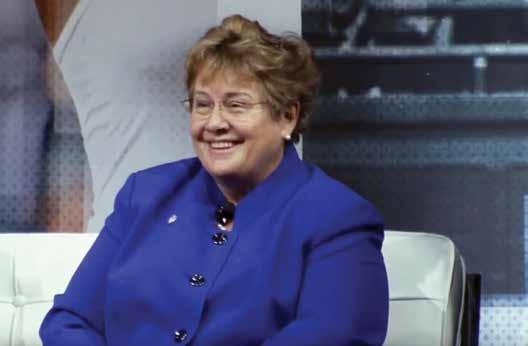
10. “We now get equal pay for Olympians and Paralympians for the medals. It’s is a big, big deal.” Deborah McFadden made the announcement during the panel discussion, Paralympic and Adaptive Sports: Challenges, Opportunities and the Future, at the 2018 LA84
Foundation Summit. McFadden is a pioneering policy maker and advocate for equal access for Para-Athletes, who served as commissioner of disabilities under President George H.W. Bush. Her daughter, Tatyana, is a 17-time Paralympic medalist.
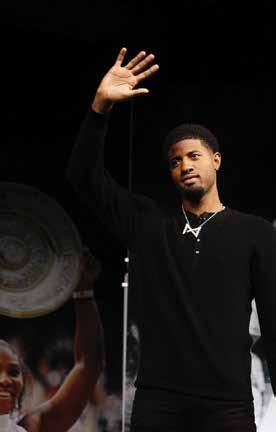
11. “I want to create something for the kids to look forward to. I want to help the community that raised me.” 2016 Olympic gold medalist and five-time NBA allstar Paul George, who spoke about working to help youth in need from his hometown of Palmdale, CA during the 2018 LA84 Foundation Summit.
12. “I feel like money – or sometimes where you live, the color of your skin, your religion – I feel like sometimes it takes the children out of the ability to be able to participate in sport. So with that, I started a nonprofit foundation called Limitless People.” 2016 Paralympic sitting volleyball gold medalist Nicky Nieves speaking at the 2018 LA84 Foundation Summit about her desire to help close the play equity gap.
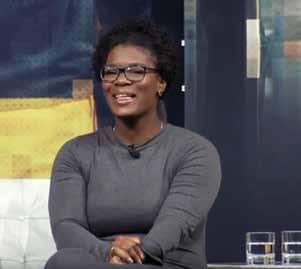

13.“I’m not only fighting for myself, but I’m fighting for everyone else who doesn’t have access to the sport.” High school student Lisa Parks, who is a plaintiff in a New York Anti-Discrimination Lawsuit, is fighting for kids in underserved areas to have equal access to sports in school. Parks was a panel speaker at the 2018 LA84 Foundation Summit and a part of the next generation of athlete activists.
20 THE OLYMPIAN NEWSLETTER
ALUMNI IN HONOR

Andy Roddick (Tennis, 2004, 2012) and Rajeev Ram (Tennis, 2016) were named the National and Indiana Pathfinder Award winners by the Indiana Sports Corporation for 2018.

ALUMNI IN THE NEWS
Dick Fosbury (Track & Field, 1968) was elected to be the County Commissioner in Ketchum, ID. Ironically, Fosbury’s vote total was 6868.

Sue Bird
Sue Bird (Basketball, 2004, 2008, 2012, 2016) joins the front office staff of the Denver Nuggets of the NBA in a basketball operations role.
Shalane Flanagan
(Track & Field, 2004, 2008, 2012, 2016) reached the podium at the NYC Marathon with a third place finish. Molly Huddle (Track & Field, 2012, 2016) and Desiree Linden (Track & Field, 2012, 2016) also finished in the top ten. Jared Ward (Track & Field, 2016) finished sixth overall in the men’s category.

Shawn White (Snowboarding, 2006, 2010, 2014, 2018) and the members of Team Shuster (Curling, 2018) were awarded Best Male Athlete and Best Male Team awards of the PyeongChang 2018 Games by the Association of National Olympic Committees at the ANOC Awards.
MILESTONES
Monique Lamoureaux-Morando (Hockey, 2010, 2014, 2018) welcomed her first child, Mickey Salvatore Morando, to the world on Dec. 11.

Nathan Adrian
(Swimming, 2008, 2012, 2016) married Hallie Ivester in early September. Congrats to the newlyweds!
 Shawn White
Team Shuster
Shawn White
Team Shuster
THE OLYMPIAN NEWSLETTER 21
Shalane Flanagan
Monique Lamoureaux-Morando
Nathan Adrian & Hallie Ivester

ALUMNI IN MEMORIAM

Jeanne Chelsey Ashworth (Speedskating, 1960, 1964, 1968)
Jeanne Chelsey Ashworth died on October 4, 2018 at age 80.
Jeanne was the first American to win a speedskating medal after the sport was reintroduced at the 1960 Olympic Winter Games in Squaw Valley. She placed third to win the bronze. She also competed at the 1964 and 1968 Winter Olympic Games. She was an excellent softball player and competed in that sport on a national level.
She received a B.S. degree in physical therapy from an affiliate school of Tufts University. Jeanne settled near Lake Placid, where she helped run the family toy and candy company. She became Town Supervisor of Wilmington, N.Y., a function comparable with mayor.
She coached speedskating for several years in Lake Placid, served on the local committee for the 1980 Winter Olympic Games and was inducted into the Lake Placid Hall of Fame in 1993.
Jeanne is survived by her daughter Kristen; sister Jackie; two grandsons; four nieces and nephews.

Keith R. “Huffer” Christiansen (Ice Hockey, 1972)
Keith Christiansen died on November 5, 2018 at age 74.
Keith graduated from International Falls High School, where he met Evelyn Sutherland and they were married in 1965. He played hockey for International Falls High School, University of Minnesota Duluth, he was a member of the silver medal winning 1972 U.S. Olympic Team.
Keith appeared in 138 World Hockey Association regular season games with the Minnesota Fighting Saints between 1972 and 1974.
He is one of the more famed UMD Bulldogs; he is in the UMD Hall of Fame and has his number 9 hung in Amsoil Arena where the Bulldogs currently play. Keith was inducted into the U.S. Hockey Hall of Fame in 2005.
What he loved most was spending time with his family and taking special trips to Puerto Vallarta and Rainy Lake.
Keith is survived by his wife, Evie; son, Brad (Jean); daughter, Marla (Juhl) Halvorson; grandchildren, Peter and Susan Christiansen and Mya and Leah Halvorson; brothers, Kenneth “Keno” (Mickey) Christiansen and Kelvin “Brush” (Marilyn) Christiansen; sisters in law, Virginia Jespersen, Donna (Dick) Hatt and Joan (Bob) Johnson and many nieces and nephews.

Donald Cohan (Sailing, 1972)
Donald Cohan died on October 20, 2018 at age 88.
Donald graduated cum laude with a Bachelor of Arts from Amherst College and a Legum Doctor degree from Harvard Law University. He was a partner at Dilworth, Paxon, Kalish and Kauffman and was known as an authority on wills, trusts and estate law on which he widely published and lectured. Later, he changed careers when he founded the Donesco Company, specializing in real estate development, investment, management and consulting. He served on numerous boards and committees including the Jewish Employment Vocational Services, the North American Friends of Israeli Oceanographic Institute and Amherst College, where he donated the Cohan Dormitory. He particularly enjoyed establishing the Balch Institute for Ethnic Studies in Philadelphia and serving on the board of governors at the Vineyard Haven Yacht Club for many years.
Donald was active in many sports throughout his life, sailing became his passion at the age of 35. He represented the United States in over 16 world and Olympic-class championships. He competed at the Munich 1972 Olympic Games and won bronze in the Dragon class. He was the first Jewish athlete to win an Olympic medal in yachting.
22 THE OLYMPIAN NEWSLETTER
ALUMNI IN MEMORIAM (continued)

A true Renaissance man, he was a scholar, an athlete, a debater, a poet, a patron of the arts, a philosopher, a historian and a family man. He was the recipient of numerous awards both personally and professionally, including the Senatorial Medal of Freedom. He battled Hodgkin’s and non-Hodgkin’s lymphoma several times and numerous brain meningiomas. His family was proud of his determination against the odds and the elements.
He is survived by his wife of 58 years, Trina (Polen) Cohan; his children, Rachel Cohan Albert, Benjamin Cohan and Susannah Cohan McQuillan; his sons in law Jonathan Albert and Joe McQuillan, and his grandchildren, Sarah and Jake Albert, Minori and Manna Cohan, Will and Matthew McQuillan, Kara McQuillan and her daughters, Kaya and Sierra Secouler. He is also survived by his step-siblings, Ron and Harvey Shapiro and Dede Ulanet; his brother in law, Stephen Polen; and many cousins, including Bob Cohan, Wilma Maskit, Jane Zeruld and Leonard Cohan.

Charles “Charley” Ray Ellis (Boxing, 1964)
Charles Ellis died on August 29, 2018 at age 75.
Charley grew up in Louisville, Ky. He served in the U.S. Army from 1962-1968.
He was a member of Team USA at the Tokyo 1964 Olympic Games. After
leaving the Olympic Games and the Army, he turned professional, winning his first fight in September 1965 against Juan Rueda.
Charley fought for eight more years, he only had 11 pro fights, and he won them all. Despite this, he never had a title fight. He retired in July 1973 after a TKO victory over Dave Wyatt.
Charley is the brother of former World Heavyweight Boxing Champion, Jimmy Ellis.

Werner P. Holzer
Werner Holzer died on October 29, 2019 at age 81.
This is the story of Werner Peter Holzer. Werner was a wonderful family man who was cherished by many, is missed, and will always be remembered for his principles and integrity.
Werner began his life on September 23, 1937, to immigrant parents, Michael and Eva Holzer. His father was a fine tailor by trade but made a living in Chicago as a tenement building manager where the children played in the open atrium of the building. ‘Mike’ set a no excuses, hard work ethic, example for the family while Eva created a loving home environment based on rules with humor.
Werner, and his brothers, Mike, Frank, and Don remained lifelong supporters
of each other’s endeavors. Trips to their great aunt’s farm in Illinois were highlights growing up.
After his brother, Mike, introduced him to wrestling, his love of the sport at a young age worked into a talent and as Werner graduated from Carl Schurz High School in 1955 with a State championship under his belt, he earned a wrestling scholarship to the University of Illinois. He became the first person in his family to go to college and he graduated from U of I with a degree in Business.
Werner met his wife, Dottie, in Southern California where she was a flight attendant and they married in 1962. The church, love, and humor played a large part in their 56-year marriage. They now have six children and eight grandchildren living coast to coast.
A notorious chocolate ice cream enthusiast, Werner and the best-man from his wedding, Frosty Devor, were known to walk the Huntington and Manhattan Beach strands in California with a pint each after a wrestling workout.
Werner worked in some form of sales his entire life including selling pots and pans in California in the early 1960s, industrial gases out of Chicago, Illinois for Airco, his own carpet company under the name Carpet Forest in Chicago, Illinois, and real estate in Illinois and Colorado (residential, commercial, and industrial). So tenacious for his seller-customers, that he once spent five years, and compelled a literal act of Congress, to complete the sale of an industrial property in Denver.
Frequent camping trips that began with tent camping and graduated to spoiling the crew with a camper
(Wrestling, 1968)
THE OLYMPIAN NEWSLETTER 23
ALUMNI IN MEMORIAM (continued)

included a favorite where Werner and Dottie packed up the car and camper and asked the kids which direction to go. Eventually the family ended up in Door County, Wisconsin on a holiday weekend without a reservation. Not to worry. Werner’s personality, negotiation skills, and knack for finding something in common with pretty much anyone landed the family in a farmer’s field of wild strawberries which created a most delicious and memorable trip.
Werner did life right! He lived the passion of his favorite sport, and loved family, friends, the outdoors, and the church. He loved being involved in sports and seemed to excel effortlessly in each: water skiing, snow skiing, backyard football, picnic sports games, swimming, diving, and of course wrestling. Choosing to lead by example in athletics as well as life, Werner circumspectly encouraged all his children to participate in athletic activities of their choice and to tenaciously follow their own paths to success.
A man of principles, Werner consciously dedicated one-on-one time to each of his six children, participating in father-son and father-daughter youth groups. Werner and his kids spent many Sundays at his parent’s Long Lake cottage with extended family where he was one of the best slalom water skiers on the lake. His children also loved Saturday morning horseback riding with the family. Werner impeccably trained the family German Shepherd, which had been purchased after the Mexico City 1968 Olympic Games and named Chica, as a show dog.
He taught Catechism at St. Zachary Catholic church in Des Plaines, Illinois where he began raising his family. He and his wife, Dottie, performed volunteer work for many years through
Catholic Charities. In 1980, through Catholic Charities, they adopted two brothers who he called a blessing, Eric and Russell, and a girl in 1993, Christine, who he referred to as his rainbow.
A love of the outdoors including skiing and hiking brought him to spend family vacations in Winter Park, Colorado and a love of real estate led to the development of a 12-unit condominium building including the first underbuilding, enclosed garage in town.
Eventually, Werner moved to a ranch south of Denver, Colorado where he learned about horses, so he could help his daughter with cerebral palsy ride and work her leg muscles. The city boy applied that typical wrestlers’ dedication and commitment to handling horses, donkeys, goats, and sheep and was soon building corrals and putting up fences, while explaining to critters that his little daughter was their boss. He roamed the hillside with the same binoculars he took on family camping trips delighting in the wildlife. Later, he would move his wife and youngest daughter to a similar property in Fallbrook, California.
Werner Holzer, the wrestler, is how most people in his life came to know him. During college he was a two-time Big Ten champion, an All-American, finishing third at the NCAA Championships in 1957, and finished his college career with a 71-7 record.
Several years after college, he became founder, fundraiser, athlete, and coach for the Mayor Daley Youth Foundation Wrestling Club in Chicago and led the club to 15 national freestyle and Greco-Roman titles between 1966 and 1978 including the first United States Wrestling Federation National Championship. He personally won a national freestyle champion title in 1966
and was a six-time All-American for the Mayor Daley Youth Foundation.
He played a key role in establishing the United States Wrestling Federation in 1968 and, alongside his best friend Steve Combs serving as Executive Director, Werner served as USWF Vice President and then as its President during the final years of its hard-fought battle for recognition as the National Governing Body for wrestling, helping guide it to become USA Wrestling in 1983. Werner authored the History of the United States Wrestling Federation/USA Wrestling which fully documents and chronicles the rise of USA Wrestling. He was proud to have been member #1 and to have served as the first President of USA Wrestling, which continues as the National Governing Body and today has more than 233,000 members.
He placed fourth in freestyle at the 1966 World Championships and finished sixth in Greco-Roman at the Mexico City Olympic Games, making him one of the few Americans to compete internationally in both styles. He was extremely proud of marching in the Olympic Games’ opening ceremony and representing his country in international events.
He thoroughly enjoyed the international aspects that wrestling brought to his life. Werner forged friendships around the globe and did not hesitate to host foreign wrestlers and teams at his home in Illinois. One of the closest international friendships he developed was with Japan’s Noriaki Kiguchi, frequently organizing wrestling exchange opportunities between the two countries. He also enjoyed maintaining a relationship with his extended family in Mexico after he was able to connect with them in 1968.
24 THE OLYMPIAN NEWSLETTER
ALUMNI IN MEMORIAM (continued)

His closest friends in the wrestling community were those wrestlers with whom he worked and fought to help create USA Wrestling. He was especially grateful for the dedication, support, and friendship of Steve Combs and Russ Hellickson before, during, and after that epic endeavor.
Werner’s wrestling family became part of his homelife as well. His children recall their dad’s wrestling buddies as the most entertaining guests. Turkish wrestlers eating whole raw onions, Noriaki playing ‘I Found My Thrill’ on the piano and singing together at family gatherings, Combs tormenting Werner about eating fries with a fork, to name a few. (Werner never-after faltered in that ‘habit.’)
Regardless of age, you could always count on a Werner greeting consisting of an arm drag, pulling you in for a hug or handshake. His welcomes were always warm and sincere, his energy was amazing, his convictions and passion towards life were infectious, and leaving you a better person was not uncommon.
Three words that could describe any world class wrestler are persistence, determination, and tenacity. Werner Holzer epitomized all three, on and off the mat, in wrestling and in life.
Werner passed peacefully in his sleep with Dottie at his side. And so, our story concludes knowing Werner will be fondly remembered by family and friends as a loving husband, amazing father and grandfather, loyal friend, man of faith, intense competitor, accomplished athlete, Olympian, successful businessman, entrepreneur, author, and proud patriot.
Special people that started the party ahead of (predeceased) Werner are his parents, Michael and Eva; brother, Mike; sister-in-law, Carol; in laws, Solon and Jean Steere; friends, Terry McCann, Jerry Rosenberg, Joe Domko, and Fred Todd.
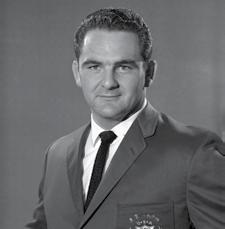
William “Pat” Lovell (Wrestling, 1964)
William “Pat” Lovell died on November 29, 2018 at age 81.
Pat was a three-year varsity starter in football and wrestling with the Mustangs from 1956-60 and received numerous post-season honors including threetime Pacific Coast Intercollegiate heavyweight wrestling champion.
Pat graduated from Cal Poly in 1963 with a bachelor’s degree in physical education. He earned his master’s degree, also in physical education, at Cal Poly in 1971.
Pat qualified for the Tokyo 1964 Olympic Games in the light heavyweight division of Greco-Roman wrestling. He has been inducted into the National Wrestling Hall of Fame, the California Wrestling Hall of Fame, the Cabrillo College Hall of Fame and, in 1989, the Cal Poly Athletics Hall of Fame.
Pat was the 1961 National AAU heavyweight Greco-Roman champion. From 1961-64 he was the National AAU
place winner in the same division and, from 1961-62 he was on the USA World Team.
He was an eight-time AAU All-American winner. In 1995 he was the National Scholastic Federation Official of the Year and was named USA Wrestling “Man of the Year.” He served as President of the USA Wrestling Officials Association and officiated high school football for 35 years and wrestling matches for 45 years. He placed in 13 national freestyle and Greco-Roman championships.
A former three-sport standout at Sequoia High School in Redwood City, Pat was a four-year wrestler at Cal Poly and earned the Pacific Coast Intercollegiate heavyweight title in 1958 and 1960. He played three years of football, competing at right tackle, and was line mates with left tackle and college roommate John Madden. He used his wrestling skills to his advantage on the football field.
Pat remained close friends with Madden and got to travel in the famous John Madden Cruiser — Madden hates to fly — when Madden was inducted into the Pro Football Hall of Fame in Canton, Ohio, in 2006.
Pat had the full support of his football teammates when he competed in wrestle-offs on the top floor of Cal Poly’s Crandall Gymnasium. His football teammates lined the stairwell leading to the wrestling room and passed along highlights — like, “he got a takedown” — so those out of view could keep up to date. He was a big deal.
Pat is survived by his wife of 50 years, Joy; son, Bobby; two daughters, Sarah and Allison; and several grandchildren.
THE OLYMPIAN NEWSLETTER 25
ALUMNI IN MEMORIAM (continued)


Daniel Puckel died on November 13, 2018 at age 85.
Daniel was a talented man of many accomplishments. His path to the Olympics began in high school as he shot rifle competitively in the ROTC program. After winning the Memphis City Rifle Championship, he attended the University of Tennessee where he was chosen on the NRA All-American team three years.
In 1956, he unselfishly served our country in the U.S. Army, where he served as a lieutenant for four years, and was selected to be a member of the newly-formed Army Advanced Marksmanship Unit.
Daniel competed at the 1959 Pan American Games where he had one of the great competitions ever, winning 9 gold medals with a total of 12 medals overall. This feat is the second-most alltime at a single Pan Am Games, trailing only American gymnast Joseph Kotys in 1955, who won 13 medals that year. He broke three world records in free rifle at the 1959 Pan Am Games. In 1960 he won an international free rifle event prior to the Olympic Games. He competed in three rifle events at the Rome 1960 Olympic Games, free rifle, small-bore rifle prone, and small-bore rifle, 3 positions.
Daniel retired as a Chemical Engineer from Eastman Chemical Company after many years of dedicated service. He was a devout member of Colonial Heights Presbyterian Church. In his spare time, he enjoyed golfing, and spending time with his family and friends. Daniel was a loving husband, father, grandfather, and friend; he will be greatly missed by all. In addition to his parents, Daniel was preceded in death by his wife, Dorothy Jean Puckel.
Left to cherish his memories are his two daughters, Paula Sue Burns & husband Jeffrey Arthur and Dana Lee Lathan & husband David Robert; four grandchildren, Ariel Nicole Lathan, Joshua Daniel Lathan, Nathanael Scott Burns, and Luca John Burns.

Douglas L. Turner (Rowing, 1956)
Douglas Turner died on November 4, 2018 at age 86.
For more than 60 years as a reporter, editor and columnist, Douglas chronicled the most important local and national stories of the late 20th and early 21st centuries. Sometimes, he even participated behind the scenes through countless interactions and influence with the top political, business and civic leaders of his day.
“He died in much the way he lived: his way, his home, his bedroom if not his
bed; surrounded by classical music and memories of Mom,” his daughter Molly Field said.
Colorful, dedicated, brilliant – yet always unpredictable – Douglas directed the Courier-Express through its fierce competition with The News during the late 1970s before the newspaper was sold and he was reassigned to its Washington bureau. During his tenure as editor he directed a Courier-Express known for hard-hitting journalism, often reflecting his “take no prisoners” directive recalled by its veterans.
In Washington, Douglas emerged as a major figure in the capital’s journalistic circles. He attended the insider briefings and circulated among power brokers –but always with the healthy skepticism of a hard-boiled reporter. Even through his last years as author of a Monday column in The News, he influenced people and events not only in Washington but back home in Buffalo, too.
He graduated from Lafayette High School in 1952, he earned a bachelor’s degree from Brown University in 1954, where he participated in varsity crew and was a member of the Jabberwocks Singing Group and Beta Theta Pi. In 1968 he studied at Stanford University’s graduate business school on a Ford Foundation fellowship.
He enlisted in the Army from 1955 to 1957, serving as a special agent in the Counter-Intelligence Corps. But he donned another U.S. uniform while discharged from the service as a rower in the 1956 Melbourne Olympic Games. His lifelong devotion to the sport stemmed from an early association with Buffalo’s West Side Rowing Club, as well as a star role on Lafayette teams that claimed championships in major events like the Royal Canadian Henley.
Daniel Bruce Puckel (Shooting, 1960)
26 THE OLYMPIAN NEWSLETTER
ALUMNI IN MEMORIAM (continued)

Mr. Turner joined the Courier in 1957, advancing as Albany bureau chief, financial editor, city editor, executive editor and Washington bureau chief. After the Courier closed in 1982, he joined The News and was bureau chief from 1982 to 2007 before working as a columnist in “retirement.”
A Renaissance man who could quote from the classics as well as comic strips, he was also deeply spiritual. For most of his life he was a deacon, elder and trustee of First Presbyterian Church in Buffalo, but converted to Catholicism at Washington’s Holy Trinity Church in 1988. He not only converted but immersed himself in all that was Catholic, able to quote canon law or theological works ranging from St. Augustine to the papers of Vatican II.
In 1962, he married Mary Joan Hassett, who died in 2013. In addition to his daughter, he is survived by two sons, Christopher and Albert; and 10 grandchildren.

Dr. Stuart Walker Sailing, 1968)
Stuart Walker died on November 11, 2018 at age 95.
Dr. Walker, who died as a result of stomach cancer, participated in his last competitive regatta this past April when he finished 10th out of 12 entries at the Soling United States National Championship that was hosted by
Severn Sailing Association.
Walker was the guest of honor at an August party held at Severn Sailing Association in anticipation of his death. In an email to family, friends and fellow SSA members, he explained the purpose of the party.
“Many years ago, I decided that if I died a great party should be given at SSA in remembrance of me,” Walker wrote. “Recently, however, when I was informed that my abdomen was filled with cancer, I decided that it would be far more fun for me to hold the party in advance of my demise.”
Walker’s last book, titled “Severn Sailing Association – The First Ten Years” was completed and printed in time for the August 26 party.
Walker was enshrined in the National Sailing Hall of Fame in 2013 and it was rather fitting the induction ceremony was held in his hometown. He was 90 years old at the time and gave a rousing speech to a large audience at City Dock. Walker’s list of accomplishments is impressive and includes representing the United States in sailing at the Mexico City 1968 Olympic Games, 1979 Pan American Games, becoming the first American to win both the Prince of Wales Trophy (England, 1964) and the Princess Elizabeth Trophy (Bermuda, 1963) and founding the Severn Sailing Association.
“I think the thing I’m most proud of is creating the Severn Sailing Association, which remains one of the premier small-boat racing clubs in this country,” Walker said prior to his induction into the National Sailing Hall of Fame.
“I take great satisfaction from seeing that, after all these years, SSA remains
true to its original mission. It is still a small boat sailing club, which is what we intended when we created it,” Walker added. “We didn’t want a bar or tennis courts. From the beginning, the purpose was pure sailboat racing and the club was for storing and launching the various fleets.”
Supporters purchased the plot for $45,000 in 1957 and Severn Sailing Association was born with Walker serving as commodore for the first five years. From the outset, SSA was dedicated to the promotion of onedesign racing and development of youth sailors.
Just as notable are Walker’s vast contributions as a sailing author, instructor and lecturer. A keen student of the sport, Walker wrote 12 books on sailboat racing that have focused on technical topics such as trimming or boat positioning, meteorological issues such as low-level wind flow or psychological aspects such as competitive behavior and the art of winning.
For a period of four decades, Walker contributed a monthly column to the publication currently called Sailing World Magazine. He has written extensively for the renowned English magazine Yachts and Yachting.
A native of Hartsdale, N.Y., Walker was introduced to sailing at the age of 12 when his father bought a 50-foot Class Q sloop and delivered it from Boston to Larchmont.
“We were true novices who learned an amazing amount about sailing on that one trip and I would spend five years of my teenage life in front of the mast of my father’s boat,” Walker said.
Walker established the intercollegiate
THE OLYMPIAN NEWSLETTER 27
ALUMNI IN MEMORIAM (continued)

sailing team at Middlebury College in Vermont and the school recently named its signature home regatta in his honor. Upon entering medical school at New York University, Walker purchased a Star class boat and competed out of Larchmont Yacht Club — thus beginning a lifelong love affair with dinghy racing. Upon joining the United States Army and being sent to Japan with a paratrooper division, Walker built a Penguin so that he could continue to sail while overseas. He specifically asked to be assigned to an East Coast base that was near a major body of water and was thrilled when the Army sent him to Fort Meade, which is located near Annapolis.
He soon discovered what a lovely place Annapolis was and decided this is where he wanted to live. So, he left the Army and started his own pediatric practice. Walker resided in Annapolis from 1953 until his death.
Walker gave up that private practice in Annapolis specifically so he could have more time for sailing. He served as Chief of Pediatrics at Mercy Hospital in Baltimore for a stretch then began teaching at the University of Maryland School of Medicine in 1961.
It was around that time when Walker grew more serious about sailboat racing and became a force on the International 14 circuit. Walker always considered capturing the Prince of Wales Cup his greatest accomplishment. It was 1964 and to that point only British competitors along with one Australian had been victorious in the prestigious event known as the America’s Cup of dinghy racing.
Walker struggled early in the competition, but spent several days
thoroughly researching the venue from a high hill overlooking the race course while acquiring insider knowledge from local watermen.
“It really was a shock to the Brits that an American could show up and win an event that they truly dominated,” said Walker, who was a member of every American team for international matches in the I-14 class from 1961 through 1971. A few years later, Walker accepted an invitation to serve as trimmer and tactician for Philadelphia skipper Gardner Cox as he mounted an Olympic campaign in the 5.5 class. It was considered quite an upset when Cox, Walker and Steve Colgate knocked off such legends as Lowell North and John Marshall to win the U.S. Trials off Newport Beach, Cal.
While the sailing competition was held off Acapulco, the 1968 Games were hosted by Mexico City. He recalled entering the Olympic stadium during the opening ceremony and hearing the roar for the United States team was “one of the greatest thrills of my lifetime.”
Walker transitioned from the International 14 to the Soling and won a slew of major events in that one-design keelboat class as well. He has been the premiere Soling sailor at Severn Sailing Association five decades, winning the annual Ice Bowl Regatta 34 out of 60 times from 1955 through 2013.
Walker has captured the Soling National Championship six times (1973, 1983, 1987, 1988, 2003, 2007) and has also enjoyed extensive success overseas in the class. He garnered the Australian Gold Cup in 1982 and has won national championships in such European countries as Hungary, Austria,
Switzerland, Scotland, Holland and Bavaria. He served as president of the Soling class from 1991-1994.
Walker, who was inducted into the Anne Arundel County Sports Hall of Fame in 1992, announced he was retiring from competitive sailboat racing due to macular degeneration.
“It was a difficult decision in advance, but not after I made it. I felt relieved,” Walker said. “It’s annoying and frustrating to not be able to perform up to your capabilities because you can’t see.”
However, it proved to be only a partial retirement as Walker continued to compete in the annual Soling Ice Bowl and created the Thomas Point Lighthouse Race that was a similar point-to-point event.
“That’s the type of race I can still do because I know the Severn River so well,” Walker said of the Ice Bowl. “It’s a distance race that does not feature many mark roundings or boat-on-boat action. I’ll sail the Ice Bowl blind if necessary!”
Walker was preceded in death by his wife of 67 years. Francis Walker, who died in September 2012, was famously fired as crew for her husband because he said she was “too incisive.”
Walker was 90 years old when he married for a second time to longtime Severn Sailing Association member Patricia Empey in the spring of 2013.”
28 THE OLYMPIAN NEWSLETTER
RECONNECT WITH YOUR FELLOW TEAMMATES
KEEP IN TOUCH
OFFICIAL USOPA SOCIAL NETWORK: www.athletenetwork.com/usopa
OFFICIAL TEAM USA NETWORK: www.teamusa.org/Team-USA-Athlete-Services/Alumni
Join our private groups on Facebook and Linked In to stay connected.
FACEBOOK:
United States Olympians and Paralympians 1,133 members
LINKED IN:
United States Olympians and Paralympians (364 members)
Olympic and Paralympic Alumni (12,876 members international)
CONNECT WITH LA 2028:
Youtube: https://www.youtube.com/channel/UC0HoUCfNT_13tkuxvtdnyA
Instagram: https://www.instagram.com/ la2028Games/
Twitter: https://twitter.com/LA2028
Facebook: https://www.facebook.com/la2028/
U.S. OLYMPIANS & PARALYMPIANS EXECUTIVE COMMITTEE 2017-2020
PRESIDENT
Dick Fosbury (Track & Field, 1968)
Contact: rfosbury68@gmail.com
VICE PRESIDENTS
Allison Baver (Speed Skating, 2002, 2006, 2010)
Contact: allison@allisonbaver.com
Carol Brown (Rowing, 1976, 1980, 1984)
Contact: carolpb@msn.com
Candace Cable (Paralympic Track and Field; 1980, 1988, 1992, 1996/Alpine Skiing; 1992/Nordic Skiing; 1994, 1998, 2002, 2006)
Contact: candace@candacecable.com
Anne Warner Cribbs (Swimming, 1960)
Contact: acribbs@basoc.org
Caryn Davies (Rowing, 2004, 2008, 2012)
Contact: caryn.davies@gmail.com
Carol Lewis (Track & Field, 1980, 1984, 1988)
Contact: misscarol63@gmail.com
Iris T. Zimmermann (Fencing, 2000)
Contact: zimmermann.iris@gmail.com
IMMEDIATE PAST PRESIDENT
Gary Hall, Sr. (Swimming, 1968, 1972, 1976)
Contact: garyhallsr@mac.com
PAST PRESIDENTS
Willie Banks (Track & Field, 1980, 1984, 1988)
Contact: bankshw@hotmail.com
John Naber (Swimming, 1976)
Contact: john@johnnaber.com
Bill Toomey (Track & Field, 1968)
Contact: williamtoomey@gmail.com
26 THE OLYMPIAN NEWSLETTER
THE OLYMPIAN NEWSLETTER 29

1. USATF’s Alumni Association has played an increasingly important role in USATF programs in recent years, and USATF now has a full-time staff person – Olympian Sharrieffa Barksdale – dedicated solely to working with alumni and integrating them more fully into USATF once their athletic careers have concluded.
As part of that effort, USATF in 2018 launched our Alumni Ambassadors Program. The program facilitates Alumni involvement in the communities where they live and work, encouraging voluntarism and providing a vehicle for alumni to engage with young people.
By providing the platform for this community involvement, the Alumni Ambassadors Program puts alumni back in the limelight and helps their local fans and youth understand the significance of USATF alumni.
In its first year, 12 alumni athletes fulfilled the 25-hours or more voluntarism requirement, which also includes sharing photos and log sheets of their community service. This inaugural class will each mentor at least one new Alumni Ambassador in 2019.
Aretha Thurmond Managing Director of International and Championship Team, Dr. John Carlos, Rose Monday, Kathy McMillan, Lacey O’Neal, Marlene Harmon Wilcox, Edwin Roberts, Mary Wineberg, Gary Morgan, Terrence Trammell and Manager of USATF Alumni Relations Sharrieffa Barksdale.


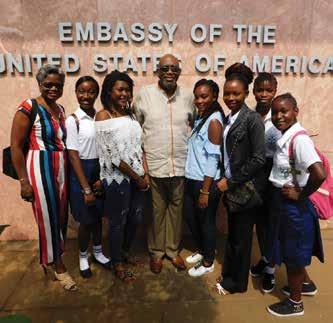
OLYMPIAN & PARALYMPIAN PHOTO Highlights
1 2 3 4 30 THE OLYMPIAN NEWSLETTER

2. - 4. In celebration of the 50th Anniversary of the Mexico City 1968 Olympic Games, Ron Freeman (track & field, 1968) and founder of The International Medalist Association (IMA) gave a presentation on “overcoming adversity” and the impact that the 1968 Olympic Games had on his life along with the history of the team. The students in the picture with him are members of the International Medalist Association. His Olympic medals, the Olympic torch that he carried and laurel wreath have been on display at the U.S Embassy for several years and the students had the opportunity to take photos with them. The United States Embassy is located in Conakry, Guinea, West Africa. To learn more about this program go to: www. internationalmedalist.org.
5. 1968 Olympians Margaret Bailes, Martha Watson, Estelle Baskerville Diehl, Maren Seidler, Barbara Ferrell Edmonson, Mildrette Netter White, Patty Van Wolvelaere and Dr. Madeline Manning Mims
6. Larry Young and his wife
7. Dr. John Carlos, Dr. Mel Pender, Jim Hines, Ron Freeman, Bob Beamon, Norm Tate
8. Sanya Richards Ross
9. Dwight Phillips
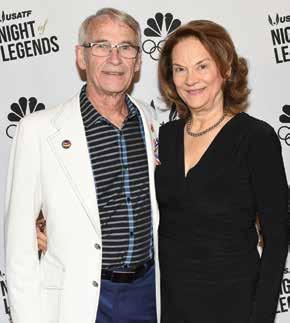



6 7 8 9 THE OLYMPIAN NEWSLETTER 31 5
UNITED STATES OLYMPIC COMMITTEE BOARD OF DIRECTORS
USOC CHAIRMAN
Larry Probst
Robert Bach
James Benson
Cheri Blauwet
Anita L. DeFrantz (rowing, 1976, 1980)
Daniel Doctoroff
Sarah Hirshland
Nina Kemppel (cross-country skiing, 1992, 1994, 1998, 2002)
Susanne Lyons
Bill Marolt (alpine skiing, 1964)
Steve Mesler (bosbled, 2002, 2006, 2010)
Dave Ogrean
Whitney Ping (table tennis, 2004)
Kikkan Randall (cross-country skiing, 2002, 2006, 2010, 2014, 2018)
Kevin White
Bob Wood
USOC CHIEF EXECUTIVE OFFICER
Sarah Hirshland
EDITORIAL STAFF
SENIOR EDITOR
Cynthia E. Stinger (team handball, 1984, 1988, 1992)
ASSOCIATE EDITOR
Christine Taylor
PRODUCTION DIRECTOR
O’Shea Design
Photos by: Getty Images, USOC Archives, Duomo, Crawford Family U.S. Olympic Archives, USOC, AP and other sources
OLYMPIANS FOR OLYMPIANS RELIEF FUND OORF - 501c3
Learn more at: www.oorf.org
Happy Holidays
U.S. OLYMPIANS & PARALYMPIANS CHAPTERS
Alabama Olympians & Paralympians
President: Jennifer Chandler Stevenson (diving, 1976) (205) 313-7436
Arizona Olympians & Paralympians
President: Misty Hyman (swimming, 2000) (650) 248-6359
Austin-San Antonio Olympians & Paralympians
President: Randy Lipscher (field hockey, 1984) (512) 699-0962
Colorado Olympians & Paralympians
President: Michelle Dusserre Farrell (gymnastics, 1984) (719) 330-4030
Dallas/Fort Worth Olympians & Paralympians
President: Sammy Walker (weightlifting, 1976) (469) 955-3158
Florida Olympians & Paralympians
President: Carrie Zimmerman (gymnastics, 1976) (850) 212-7846
Georgia Olympians & Paralympians TBD (elections pending)
Hawaii Olympians & Paralympians
President: Brent Berk (swimming, 1968) (808) 395-0600
Houston Olympians & Paralympians
President: Jacqueline Washington (track & field, 1984) (832) 488-8573
Idaho Olympians & Paralympians
President: Dick Fosbury (track & field, 1968) (208) 720-2352
Indiana Olympians & Paralympians
President: Ollan Cassell (track & field, 1964) (317) 253-1162
Louisiana Olympians & Paralympians
President: Hollis Conway (track & field, 1988, 1992) (318) 237-2382
Michigan Olympians & Paralympians
President: Gary F. Morgan (track & field, 1988) (248) 396-4936
Midwest Olympians & Paralympians
President: Diane Simpson (rhythmic gymnastics, 1988) (847) 452-7843
Minnesota Olympians & Paralympians
President: Katrina Radke (swimming, 1988) (651) 335-3647
Missouri/Illinois Olympians & Paralympians
President: John Carenza (soccer, 1972) (314) 662-4990
National Capital Area Olympians & Paralympians
President: Arlene Limas (taekwondo, 1988) (540) 720-1988
Nevada Olympians & Paralympians
President: Dean Willeford (water polo, 1968) (775) 827-1775
New England Area Olympians & Paralympians
President: Sharon Ann Jewell (taekwondo, 1988) (404) 668-7896
New Mexico Olympians & Paralympians
President: Trish K. Porter Topmiller (track & field, 1988) (505) 459-9732
Northern California Olympians & Paralympians
Interim President: Julia Nichols (rowing, 2012) (415) 441-0521
NY, NJ, CT Olympians & Paralympians
President: Craig Gilbert (team handball, 1984) (925) 577-7638
Oklahoma Olympians & Paralympians
President: Josh C. Davis (swimming, 1996, 2000) (210) 889-7667
Oregon Olympians & Paralympians
President: John McArdle (track & field, 1980) (541) 917-4210
San Diego Olympians & Paralympians
President: Erin Aldrich-Shean (track & field, 2000) (214) 725-9926
Southern California Olympians & Paralympians
President: John Moffet (swimming, 1980, 1984) (310) 994-4647
Utah Olympians & Paralympians
President: Bill A. Schuffenhauer (bobsled, 2002, 2006, 2010) (385) 237-7037
Washington Olympians & Paralympians
President: Caroline Holmes (gymnastics, 1968) (206) 246-2934
Western PA-OH-WV Olympians & Paralympians
TBD (elections pending)
No chapter in your area?
Interested in starting a chapter?
Contact the U.S. Olympians & Paralympians
Association office for details at: (800) 717-7555
www.teamusa.org
OOR F
32 THE OLYMPIAN NEWSLETTER
























































 Shawn White
Team Shuster
Shawn White
Team Shuster




















